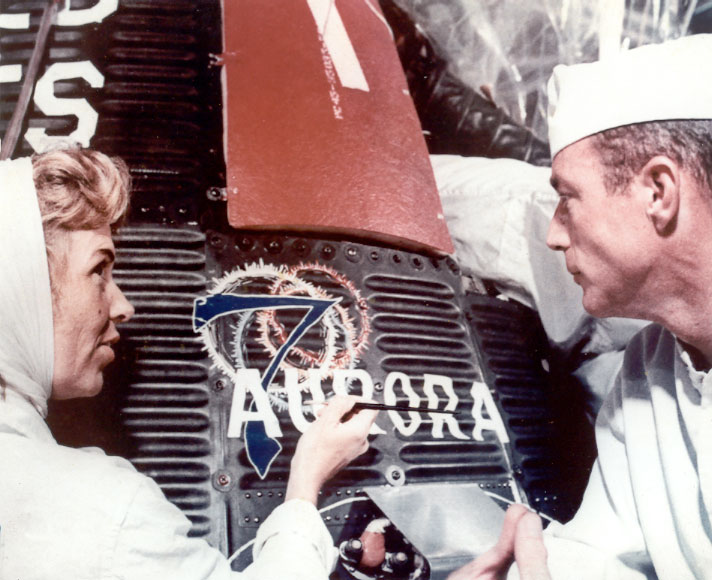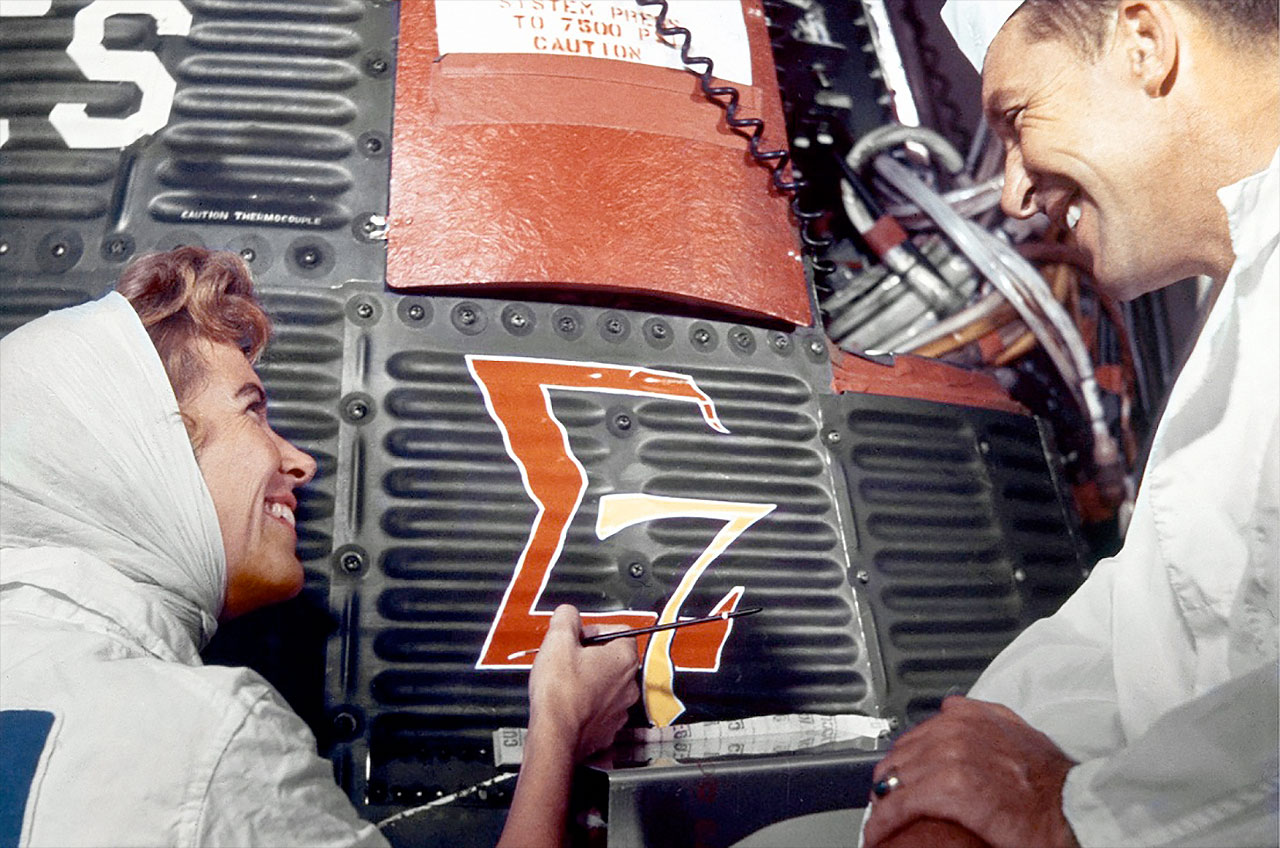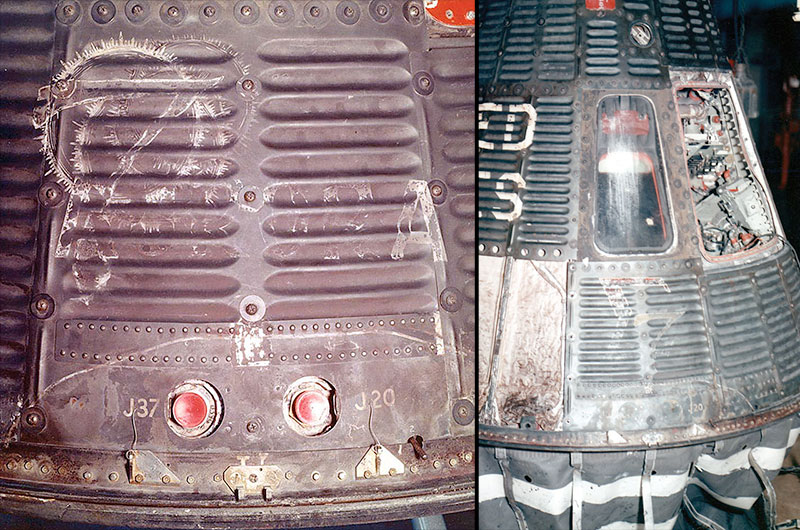'Nose art' from two Mercury astronauts' capsules resurface at auction

Once believed to be lost to history, two spacecraft shingles bearing the "nose art" from a pair of early NASA astronaut capsules have sold at auction for almost half a million dollars.
The exterior panels from Scott Carpenter's and Wally Schirra's Mercury capsules were sold by RR Auction of Boston on Thursday (Oct. 15) for $213,090 and $240,001.25, respectively. Each metal shingle displayed the burnt remnants of its spacecraft's hand-painted logo, "Aurora 7" or "Sigma 7."
The shingles were won by two high bidders in the U.S. and United Kingdom.
Behind the scenes: Inside Scott Carpenter's 1962 Mercury flight (photos)
Launched in May 1962, the Aurora 7 capsule carried Carpenter on the second U.S. orbital spaceflight, Mercury-Atlas 7, completing three trips around Earth in five hours. Schirra followed Carpenter into space aboard Sigma 7 five months later, doubling the number of orbits during his nine-hour Mercury-Atlas 8 mission.
Both astronauts sought the help of Chrysler Aerospace artist Cecelia "Cece" Bibby to design and hand paint their chosen logos on the side of their Mercury capsules. Bibby had done the same for John Glenn and his Friendship 7 capsule, which resulted in her becoming the first woman to ascend a U.S. rocket gantry to enter the protective white room that surrounded the spacecraft. (The shingle that Bibby painted with the Friendship 7 logo remains part of the spacecraft now on display at the National Air and Space Museum in Washington, D.C.)

When the logos were first added to the capsules, Bibby's designs were bold and colorful. Carpenter's Aurora 7 logo featured white lettering, a blue "7" and rings in yellow, blue, orange and red. Schirra's Sigma 7 artwork included the Greek letter sigma in red and an Arabic numeral "7" in yellow.
Get the Space.com Newsletter
Breaking space news, the latest updates on rocket launches, skywatching events and more!
The heat produced during the capsules' reentries into Earth's atmosphere left both emblems damaged, with large sections of their paint burned off. When the spacecraft were transferred to the Smithsonian and they went on public display — Aurora 7 is at the Museum of Science and Industry in Chicago and Sigma 7 is at the Kennedy Space Center Visitor Complex in Florida — the logos were not visible and some assumed that they had been scorched off completely.
Rather, unknown or perhaps forgotten by many, NASA had provided the shingles to John Radavich, a materials researcher at Purdue University in Indiana, for his evaluation. Radavich specialized in high temperature material technologies, such as the nickel-based alloy René 41 from which the spacecraft panels were made.

"Dr. Radavich, who also serves as an industrial consultant, is conducting research to determine the structural changes which occur in the heat shingle material, René 41, in reentry and during orbit," reported the Lafayette, Indiana Journal & Courier newspaper in December 1962. "Dr. Radavich's metallurgical research involves use of highly-precise procedures which include X-ray diffraction, electron microscopy, chemical digestion and similar techniques."
According to RR Auction, "contemporaneous evidence" supports that NASA did not anticipate the return of the shingles given the destructive nature of Radavich's work. "The 'fragmentary dissection' performed by Dr. Radavich is evident on this panel today," the auction house wrote.
Post-flight photography of the same shingles shows that most, if not all of the apparent degradation to Bibby's logos were a product of their plunge back to Earth and not a result of Radavich's work.

Radavich died in 2019 at the age of 96. Bibby died in 2012 at 84. Carpenter, 88, was laid to rest in 2013, and Schirra died in 2007 at the age of 84.
In addition to the two logo panels, RR Auction also sold on Thursday a second Sigma 7 spacecraft shingle from Radavich's estate for $6,816.25 and two Gemini capsule shingles for $6,196.25 and $1,971.25.
Follow collectSPACE.com on Facebook and on Twitter at @collectSPACE. Copyright 2020 collectSPACE.com. All rights reserved.
Join our Space Forums to keep talking space on the latest missions, night sky and more! And if you have a news tip, correction or comment, let us know at: community@space.com.

Robert Pearlman is a space historian, journalist and the founder and editor of collectSPACE.com, a daily news publication and community devoted to space history with a particular focus on how and where space exploration intersects with pop culture. Pearlman is also a contributing writer for Space.com and co-author of "Space Stations: The Art, Science, and Reality of Working in Space” published by Smithsonian Books in 2018.In 2009, he was inducted into the U.S. Space Camp Hall of Fame in Huntsville, Alabama. In 2021, he was honored by the American Astronautical Society with the Ordway Award for Sustained Excellence in Spaceflight History. In 2023, the National Space Club Florida Committee recognized Pearlman with the Kolcum News and Communications Award for excellence in telling the space story along the Space Coast and throughout the world.

